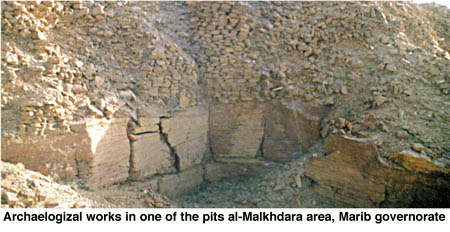
Ancient Sabaean gold mine discovery So this is where Queen Sheba got her gold! [Archives:2003/04/Last Page]
January 27 2003

BY HASSAN AL-ZAIDI
YEMEN TIMES STAFF
Al-Makhdara is a small uninhabited historical town located below Mount Hailan a few kilometers to the west of Marib City, where an American company has recently crowned its year-long exploration with a discovery of a gold mine. It is said that the mine dates back to the Sabaean times in the 6th century BC. The place is full of rock piles of various types designed in circular shapes. Historians say that these are tombs of the old Sheba kingdom. Yet the locals of the area insist that these sites were built around 570 AD by the Ethiopian king who used them as a shield to protect him from the ‘Ababeel’ birds that attacked him and his elephants upon his attempt to demolish the holy Kaabaa in Mecca City as narrated in the Holy Quran.
In contrast to this claim, explorations indicate that the area was actually one of the largest Sabaean mines in the area and was once full of gold and precious gems.
Deep underground caves that capacitate more than a square kilometer of land have also been discovered. The various holes in the ground in different places of the town confirm the theory of the gold mine. There are also several settings of rocks that seem to have been forming a filtering device that would separate gold from other waste by burning mine excavations.
The discovery also shows that Sabaeans used highly sophisticated tools to extract gold from the mines. To shape the gems, they used sharp tools and complex equipment that was not known by many at the time.
On the other hand, curious villagers in the area discovered remains of ashes in some of the rock piles, adding to the strength of the conclusion that these piles were used as furnaces for melting the extracted gold.
An interesting fact is that the 80-kilometer road leading to the old Sabaean Capital Sirwah starts from this particular site, and that this road remains paved with stones and rocks until today.
Not to mislead our reader, we need to emphasize that almost everything that was in this mine was found except one thing: the gold! The question of whether there is any gold left from that era still remains.
Another question that could be raised at this time would be “what about the tourist value of the discovery?” Al-Makhdara could be one of the links in the Sheba Kingdom mystery’s chain. So will there be any positive response from the concerned authorities in the ministry of tourism or any governmental body regarding this discovery?
According to the villagers, Yemen Times was the first newspaper to explore this area and reveal those astonishing facts about the discovery. However, the paper has also found another site that is not less important. It is remarkable to know that in such a dry governorate, there is currently a sulfur-rich spring near the site of the discovery, which villages say has been flowing non-stop throughout the last century or more and has been effective in curing many skin diseases. Hence, villagers come from all over the governorate to enjoy bathing in those warm and ‘healthy’ springs.
The journey to Al-Makhdara, which is only 3 kilometers away of the main highway between Marib and Sana’a was an enjoyable endeavor full of great experience to discover and appreciate the greatness of our ancestors whose civilizations and power was beyond imagination. It is sad however that the area is totally ignored -as villagers confirm- by the government and tourist agencies, resulting in a great economical potential being lost in front of our own naked eyes. It is a pity that our ancestors who were able to build dams and great cities would not be proud of our conditions today!
——
[archive-e:04-v:2003-y:2003-d:2003-01-27-p:./2003/iss04/lastpage.htm]


